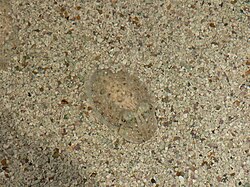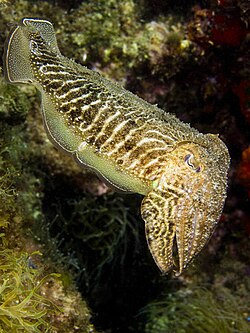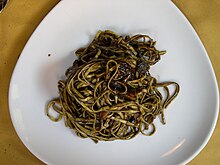Cuttlefish
| Cuttlefish | |
|---|---|

| |
| Sepia latimanus, East Timor | |
| Scientific classification | |
| Domain: | Eukaryota |
| Kingdom: | Animalia |
| Phylum: | Mollusca |
| Class: | Cephalopoda |
| Superorder: | Decapodiformes |
| Order: | Sepiida Zittel, 1895 |
| Suborders and Families | |
Cuttlefish are marine animals of the order Sepiida. They belong to the class Cephalopoda, which also includes squid, octopuses, claims, and nautiluses. 'Cuttle' is a reference to their unique internal shell, the cuttlebone. Despite their name, cuttlefish are not fish but molluscs.
Cuttlefish have large, W-shaped pupils, eight arms, and two tentacles furnished with denticulated suckers, with which they secure their prey. They generally range in size from 15 to 25 cm (5.9 to 9.8 in), with the largest species, Sepia apama, reaching 50 cm (20 in) in mantle length and over 10.5 kg (23 lb) in weight.[1]
Cuttlefish eat small molluscs, crabs, shrimp, fish, octopuses, worms, and other cuttlefish. Their predators include dolphins, sharks, fish, seals, seabirds, and other cuttlefish. Their life expectancy is about one to two years. Recent studies indicate cuttlefish are among the most intelligent invertebrates.[2] Cuttlefish also have one of the largest brain-to-body size ratios of all invertebrates.[2]
The 'cuttle' in 'cuttlefish' comes from the Old English word cudele, meaning 'cuttlefish', which may be cognate with the Old Norse koddi ('cushion') and the Middle Low German küdel ('pouch').[citation needed] The Greco-Roman world valued the cephalopod as a source of the unique brown pigment the creature releases from its siphon when it is alarmed. The word for it in both Greek and Latin, sepia, is now used to refer to a brown pigment in English.
Physiology
Cuttlebone
A cuttlefish possesses an internal structure called the cuttlebone, which is porous and is made of aragonite. This provides it with buoyancy, which it regulates by changing the gas-to-liquid ratio in the chambered cuttlebone via the ventral siphuncle.[3] Each species' cuttlebone has a distinct shape, size, and pattern of ridges or texture. The cuttlebone is unique to cuttlefish, and is one of the features that distinguish them from their squid relatives. Jewellers and silversmiths traditionally use cuttlebones as moulds for casting small objects,[4] but they are probably better known as the tough material given to parakeets and other caged birds as a source of dietary calcium.

Skin

Cuttlefish are sometimes referred to as the "chameleons of the sea" because of their remarkable ability to rapidly alter their skin color at will. Cuttlefish change color and pattern (including of light polarisation and even texture) to communicate to other cuttlefish, to camouflage themselves, and in deimatic display to warn off potential predators.
This color-changing function is produced by groups of red, yellow, brown, and black pigmented chromatophores above a layer of reflective iridophores and leucophores, with up to 200 of these specialized pigment cells per square millimeter,[5] which would correspond to about 359 DPI if they could be individually controlled. The pigmented chromatophores have a sac of pigment and a large membrane that is folded when retracted. The six to 20 small muscle cells on the sides can contract to squash the elastic sac into a disc against the skin. Yellow chromatophores (xanthophores) are closest to the surface of the skin, red and orange are below (erythrophores), and brown or black are just above the iridophore layer (melanophores). The iridophores reflect blue and green light. Iridophores are plates of chitin or protein, which can reflect the environment around a cuttlefish. They are responsible for the metallic blues, greens, golds, and silvers often seen on cuttlefish. All of these cells can be used in combinations. For example, orange is produced by red and yellow chromatophores,[contradictory][dubious – discuss] while purple can be created by a red chromatophore and an iridophore. The cuttlefish can also use an iridophore and a yellow chromatophore to produce a brighter green. As well as being able to influence the color of light as it reflects off their skin, cuttlefish can also affect the light's polarization, which can be used to signal to other marine animals, many of which can also sense polarization.[6]
Camouflage
Cuttlefish, although color-blind,[dubious – discuss] are able to change the color of their skin.[7] The chromatophores are elastic sacs containing different pigments. Bands of muscle radiate from each chromatophore and are controlled by neurons from the motor centres in the brain. The cuttlefish can control the contraction and relaxation of the muscles around individual chromatophores, thereby opening or closing the elastic sacs and allowing different levels of pigment to emerge. This allows the cuttlefish to change its color at will to match its background for camouflage. Reflecting plates called leucophores and iridophores are specialized to reflect certain wavelengths of light and can be used in conjunction with the chromatophores to create shimmering color effects on the skin. The reflectance spectra of cuttlefish camouflage patterns and several natural substrates (stipple, mottle, disruptive) can be measured using an optic spectrometer.[8] The color variations in the substrate and animal skin are very similar. Depending on the species, the skin of cuttlefish responds to substrate changes in distinctive ways. By changing naturalistic backgrounds, the camouflage responses of different species can be measured.[9] Sepia officinalis changes color to match the substrate by disruptive patterning (contrast to break up the outline), where as S. pharanonis matches the substrate by blending in. Although camouflage is achieved in different ways, and in an absence of color vision, both species change their skin colors to match the substrate. Cuttlefish adapt their own camouflage pattern for a particular habitat. An animal could settle in the sand and appear one way, with another animal a few feet away settled in algae and camouflaged differently. Cuttlefish can also camouflage themselves in pitch-black oceans.[10] Cuttlefish can assess their surroundings and match the color, contrast and texture of the substrate even in total darkness.
Eyes

Cuttlefish, like other cephalopods, have sophisticated eyes. The organogenesis and final structure of the cephalopod eye differs fundamentally from that of vertebrates such as humans.[11] Superficial similarities between cephalopod and vertebrate eyes are thought to be examples of convergent evolution. The cuttlefish pupil is a smoothly curving W-shape.[12][13] Although cuttlefish cannot see color,[14] they can perceive the polarization of light, which enhances their perception of contrast. They have two spots of concentrated sensor cells on their retina (known as foveae), one to look more forward, and one to look more backward. The eye changes focus by shifting the position of the entire lens with respect to the retina, instead of reshaping the lens as in mammals. Unlike the vertebrate eye, there is no blind spot, because the optic nerve is positioned behind the retina.
Cuttlefish's eyes are speculated to be fully developed before birth and start observing their surroundings while still in the egg, and may prefer to hunt the prey they saw before hatching.[15]

Suckers
The suckers of cuttlefish extend most of the length of their arms and along the distal portion of their tentacles.
Circulation
The blood of a cuttlefish is an unusual shade of green-blue because it uses the copper-containing protein hemocyanin to carry oxygen instead of the red, iron-containing protein hemoglobin found in vertebrates' blood. The blood is pumped by three separate hearts: two branchial hearts pump blood to the cuttlefish's pair of gills (one heart for each), and the third pumps blood around the rest of the body. Cuttlefish blood must flow more rapidly than that of most other animals because hemocyanin carries substantially less oxygen than hemoglobin.
Ink
Cuttlefish have ink, like squid and octopus species, which they use to help evade predators.[citation needed] This ink is stored inside an ink sac.
Toxicity
Like octopuses and some squid, all cuttlefish have neurotoxins produced by bacteria in their saliva.[16]

The muscles of Metasepia pfefferi (the Flamboyant Cuttlefish) contain a highly toxic compound that is yet to be identified.[2] Mark Norman with Museum Victoria in Victoria, Australia, has shown the toxin to be as lethal as that of a fellow cephalopod, the blue-ringed octopus.[17]
Ecology
Diet
While the preferred diet of cuttlefish is crabs and fish, they feed on small shrimp shortly after hatching.[18]
They use their camouflage to hunt and sneak up on their prey.[19] They swim at the bottom, where shrimp and crabs are found and shoot out a jet of water to uncover the prey buried in the sand. Then when the prey are trying to get away, the cuttlefish open their eight arms and shoot out two long feeding tentacles to grab them. On the end of each, a pad covered in suckers grabs and pulls prey toward its beak, where it gets paralyzed by poison and then eaten.[18]
Range and habitat
Family Sepiidae, which contains all cuttlefish, inhabit tropical/temperate ocean waters. They are mostly shallow-water animals, although they are known to go to depths of about 600 m (2,000 ft).[20] They have an unusual biogeographic pattern: totally absent from the Americas, but present along the coasts of East and South Asia, Western Europe, and the Mediterranean, as well as all coasts of Africa and Australia. By the time the family evolved, ostensibly in the Old World, the North Atlantic possibly had become too cold and deep for these warm-water species to cross.[21]
Mating
[22] Male cuttlefish challenge one another for dominance and the best den during mating season. During this challenge, no direct contact is usually made. The animals threaten each other until one of them backs down and swims away. Eventually, the larger male cuttlefish mate with the females by grabbing them with their tentacles, turning the female so that the two animals are face-to-face, then using a specialized tentacle to insert sperm sacs into an opening near the female's mouth. The male then guards the female until she lays the eggs a few hours later. On occasion, a large competitor arrives to threaten the male cuttlefish. In these instances, the male will first attempt to intimidate the other fish. If the competitor does not flee, the male will eventually attack it to force it away, and the confrontation turns physical. The cuttlefish that can paralyze the other first by forcing it near its mouth would win the fight, and the female. Since there are roughly four or five (sometimes as high as ten) males for every female, this kind of behavior is inevitable.[23] Since cuttlefish are indeterminate growers, small cuttlefish always have a chance at finding a mate the next year, when they are bigger.[24] Additionally, cuttlefish unable to win in a direct confrontation with a guard male have been observed employing several other tactics to acquire a mate. The most successful of these methods is also one of the most remarkable; smaller cuttlefish will use their camouflage abilities to disguise themselves as a female cuttlefish. Changing their coloration, hiding their extra arms (males have four pairs, females only have three), and even pretending to be holding an egg sack, disguised males are able to swim past the larger guard male and mate with the female.[23][25] Female cuttlefish will mate with several males, storing the sperm and later deciding which one to fertilize the eggs with; studies show that females will more often choose the males that employed this mating trick. This may be an adaptation in order to select for greater intelligence.[26]
Taxonomy

Over 120 species of cuttlefish are currently recognised, grouped into five genera. Sepiadariidae contains seven species and two genera; all the rest are in Sepiidae.
- Class Cephalopoda
- Subclass Nautiloidea: nautilus
- Subclass Coleoidea: squid, octopus, cuttlefish
- Superorder Octopodiformes
- Superorder Decapodiformes
- ?Order †Boletzkyida
- Order Spirulida: Ram's horn squid
- Order Sepiida: cuttlefish
- Suborder †Vasseuriina
- Family †Vasseuriidae
- Family †Belosepiellidae
- Suborder Sepiina
- Family †Belosaepiidae
- Family Sepiadariidae
- Family Sepiidae
- Suborder †Vasseuriina
- Order Sepiolida: bobtail squid
- Order Teuthida: squid
Uses
Gastronomy
Cuttlefish are caught for food in the Mediterranean, East Asia, the English Channel, and elsewhere.
In East Asia, dried, shredded cuttlefish is a popular snack food.

Cuttlefish are popular in Italy. For example, in the northeast, they are used in risotto al nero di seppia 'risotto with cuttlefish ink', also found in Croatia as crni rižot 'black risotto'.
Spanish cuisine, especially that of the coastal regions, uses cuttlefish and squid ink in a variety of dishes. Breaded and deep-fried cuttlefish is a popular dish in Andalusia.
In Portugal, cuttlefish is present in many popular dishes. Chocos com tinta 'cuttlefish in black ink', for example, is grilled cuttlefish in a sauce of its own ink. Cuttlefish is also popular in the region of Setúbal, where it is served as deep-fried strips or in a variant of feijoada, with red kidney beans.
Black pasta is often made using cuttlefish ink.
Sepia
Cuttlefish ink was formerly an important dye, called sepia. Today, artificial dyes have mostly replaced natural sepia.
Research
Research into replicating biological color-changing has led to engineering artificial chromatophores out of small devices known as dielectric elastomer actuators. Engineers at the University of Bristol[27] have engineered soft materials that mimic a cuttlefish's color-changing skin, paving the way for "smart clothing" and camouflage applications.[28]
See also
References
- ^ Reid, A., P. Jereb, & C. F. E. Roper 2005. Family Sepiidae. In: P. Jereb & C. F. E. Roper, eds. Cephalopods of the world. An annotated and illustrated catalogue of species known to date. Volume 1. Chambered nautiluses and sepioids (Nautilidae, Sepiidae, Sepiolidae, Sepiadariidae, Idiosepiidae and Spirulidae). FAO Species Catalogue for Fishery Purposes. No. 4, Vol. 1. Rome, FAO. pp. 57–152.
- ^ a b c NOVA, 2007. Cuttlefish: Kings of Camouflage. (television program) NOVA, PBS, April 3, 2007.
- ^ Attention: This template ({{cite doi}}) is deprecated. To cite the publication identified by doi:10.1016/j.epsl.2006.04.025, please use {{cite journal}} (if it was published in a bona fide academic journal, otherwise {{cite report}} with
|doi=10.1016/j.epsl.2006.04.025instead. - ^ Casting Silver with Cuttlefish. Silverstall.com. Retrieved on 2011-09-18.
- ^ NOVA | Kings of Camouflage | Anatomy of a Cuttlefish (non-Flash) | PBS
- ^ Mäthger, L. M., Shashar, N., and R. T. Hanlon. 2009. "Do cephalopods communicate using polarized light reflections from their skin?" Journal of Experimental Biology 212: 2133–2140. doi:10.1242/jeb.020800
- ^ Stuart-Fox, D. and Moussalli, A. 2008. "Camouflage, communication and thermoregulation: lessons from colour changing organisms". Philo Trans R Soc Lond B Biol Sci. 364(1516): 463–470.
- ^ Mathger, L. M., Chiao, C., Barbosa, A., and Hanlon, R. T. 2008. "Color matching on natural substrates in cuttlefish, Sepia officinalis." J. Comp. Physiol. A -Neuroethol. Sens. Neural Behav. Physiol. 194(6): 577–585.
- ^ Shohet, A., Baddeley, R., Anderson, J., and Osorio, D. 2007. "Cuttlefish camouflage: a quantitative study of patterning". Biol. J. Linn. Soc. 92(2): 335–345.}
- ^ Cuttlefish Change Color, Shape-Shift to Elude Predators
- ^ Muller, Matthew. "Development of the Eye in Vertebrates and Cephalopods and Its Implications for Retinal Structure". The Cephalopod Eye. Davidson College Biology Department. Retrieved 2007-04-06.
- ^ Template:Cite PMID
- ^ Attention: This template ({{cite doi}}) is deprecated. To cite the publication identified by doi:10.1002/jez.1402560505, please use {{cite journal}} (if it was published in a bona fide academic journal, otherwise {{cite report}} with
|doi=10.1002/jez.1402560505instead. - ^ Mäthger, Lydia M. "Color blindness and contrast perception in cuttlefish (Sepia officinalis) determined by a visual sensorimotor assay" (PDF). Vision Research, Volume 46, Issue 11, May 2006. Elsevier Ltd. Retrieved 2007-09-03.
- ^ "Cuttlefish spot target prey early". BBC News. 2008-06-05. Retrieved 2008-05-06.
- ^ All Octopuses Are Venomous, Study Says. News.nationalgeographic.com (2010-10-28). Retrieved on 2011-09-18.
- ^ Teacher's Guide to NOVA episode – Kings of Camouflage on PBS (After Watching: Activity 2).
- ^ a b Cuttlefish Basics. Tonmo.com (2003-02-12). Retrieved on 2011-09-18.
- ^ Cousteau, Jacques; Diolé, Philippe (1973). Octopus and Squid, the Soft Intelligence. Garden City, N.Y.
{{cite book}}: CS1 maint: location missing publisher (link) - ^ Lu, C. C. and C. F. E. Roper. 1991. Aspects of the biology of Sepia cultrata from southeastern Australia. In: La Seiche, The Cuttlefish. Boucaud-Camou, E. (Ed). Caen, France; Centre de Publications de l'Université de Caen: 192.
- ^ Young, R. E., M. Vecchione and D. Donovan (1998). "The evolution of coleoid cephalopods and their present biodiversity and ecology". South African Journal of Marine Science. 20: 393. doi:10.2989/025776198784126287.
{{cite journal}}: CS1 maint: multiple names: authors list (link) - ^ Bavendam, Fred. "The Giant Cuttlefish Chameleon of the Reef". National Geographic 1995: 94–107. Print.
- ^ a b Mating Trick: Science Videos - Science News - ScienCentral
- ^ Life: Cuttlefish Wards Off Rivals : Video : Discovery Channel
- ^ Cuttlefish win mates with transvestite antics : Nature News
- ^ Hanlon, Roger T., et al. "Behavioural Ecology: Transient Sexual Mimicry Leads to Fertilization." Nature 20 Jan. 2005: 212. Hermes.mbl.edu. Web. 11 June 2013. <http://hermes.mbl.edu/mrc/hanlon/pdfs/Hanlon_et_al_Nature_2005.pdf>.
- ^ Jonathan Rossiter; Yap, Bryan; Conn, Andrew; et al. (2012). "Biomimetic chromatophores for camouflage and soft active surfaces". Bioinspiration & Biomimetics. 3. 7 (36009). IOPscience: 036009. doi:10.1088/1748-3182/7/3/036009.
{{cite journal}}: Cite has empty unknown parameter:|trans_title=(help); Explicit use of et al. in:|author=(help); Unknown parameter|month=ignored (help) - ^ Anthes, Emily. "Cuttlefish provide smart fashion tips". BBC.com. Retrieved 30 October 2012.
External links
- TONMO.com Community Forum – Keeping cuttlefish in the home aquarium
- University of Texas Medical Branch's Cephbase; photos and videos of cuttlefish and other cephalopods (archived version dated January 18, 2006) NO LONGER UPDATED, from the Wayback Machine.
- YouTube video with examples of color and texture modulation.
- Youtube video Cuttlefish changing colour and shape
- Amazing cuttlefish – Cephalopods with natural camouflage and sepia ink
- Cuttlefish: Kings of Camouflage NOVA episode on PBS.org
- Interactive: Anatomy of a Cuttlefish on NOVAbeta
l
